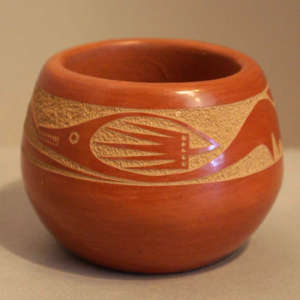Shapes and Forms: Plates and Bowls
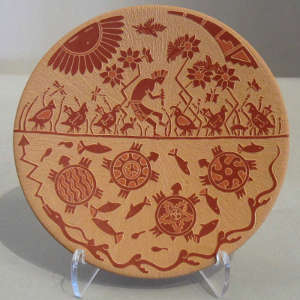
Red plate with sgraffito quail, turtle, kokopelli, fish and geometric design
Debra Duwyenie, Santa Clara
0.5 in H by 4.5 in Dia

Black-on-black plate with carved and etched feather and geometric design
Dolores Curran, Santa Clara
1 in H by 7.5 in Dia
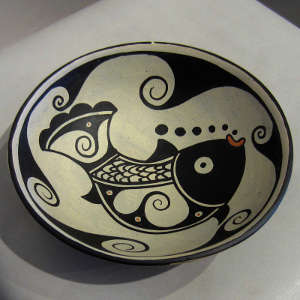
Polychrome bowl with fish and water symbols inside, water symbols outside
Thomas Tenorio, Santo Domingo
2.25 in H by 8 in Dia
Plates and Bowls is self-defining, although the pueblos do make some plates and bowls that are really small and others really large. The larger bowls also seem to be more utilitarian than decorative while plates all seem to be purely decorative.
There was a time, back in the 1300s and 1400s, when feasting became a big part of pueblo life. The feasts are assumed to have been methods used to help residents meet and greet newcomers and get to know them. Feasting spread all across the land of the pueblos, there were people on the move everywhere. With that movement, a new spiritual horizon was introduced everywhere, too. Feasts still happened after the Spanish arrived, they were just taken over by the priests and used to convey "Christian" messages.
There are still quite a few older, unsigned large dough bowls from Zia and Santo Domingo floating around. Most I have seen were decorated on the outside, polished on the inside, and clearly utilitarian. I've even found a couple with bits of dough still in them. I've seen smaller bowls from most pueblos and miniature ones from Kimo Decora of Isleta and Thomas Natseway of Laguna.
Some potters in Mata Ortiz also have plate and bowl construction down really well, but their work is also purely artwork as the entire Mata Ortiz/Casas Grandes revival has never been about utilitarian pottery.
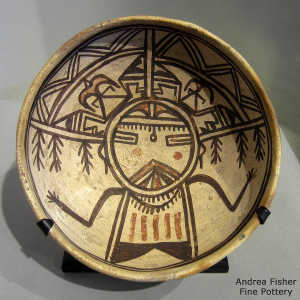
Polacca C polychrome bowl decorated inside with a Palhik Mana design
attributed to Nampeyo of Hano
2.5 in H by 7.25 in Dia
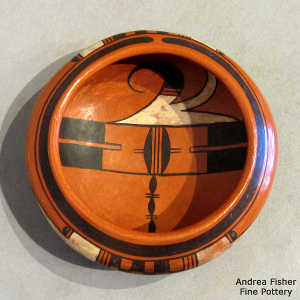
Polychrome red ware bowl decorated with a bird element and geometric design inside and out, by Rachel Sahmie, Hopi-Tewa
1.75 in H by 4.75 in Dia
Above my desk is a Hopi-Tewa yellowware bowl made by Nyla Sahmie. The inside is painted with the mythical "bird-hanging-from-sky-band" design, an image that goes back more than 700 years. Nyla is a great-great granddaughter of Nampeyo, a woman attributed with the rebirth of prehistoric Sikyátki designs and yellow ware pottery.
I've worked with Nyla and her sister Rachel to determine the authenticity of pottery attributed to Nampeyo. Nampeyo never signed anything but after she went completely blind (around 1920), her daughters and nieces did her painting for her. Fannie (Nampeyo's youngest daughter) would sign "Nampeyo Fannie" on pieces her mother made and she painted. (On her own pottery, Fannie signed "Fannie Nampeyo". Annie Healing (Nampeyo's oldest daughter) painted a few for Nampeyo but I have yet to see one that was signed.
When Rachel checked out the physical and design characteristics of each piece she explained to me what she was looking for as she did it. Nyla just held the piece in her hands and "felt" the clay. I handed Rachel a piece that I knew was a bit different and her almost immediate response was "Nope, this isn't from Grandma." Then she handed it to Nyla who held it in her hands for a moment and said, "This was made by Grace [Chapella]. Grace lived across the street from Grandma. Grandma taught Grace how to make pottery."
The piece in question was between 80 and 100 years old, decorated with Awatovi and Sikyátki-style designs and in excellent condition. It also had several images of the moth on it, more a signature design of Grace than of Nampeyo. The piece was made after most of the Hopi-Tewa made the changeover to Jeddito yellow clay, a changeover elicited by Nampeyo's growing success in the marketplace. That would have put its creation between 1915 and 1935. But it wasn't signed and Grace was one of the first to sign her pieces, beginning somewhere around 1925.
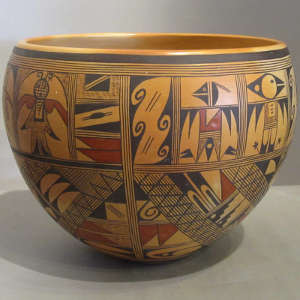
Yellow ware bowl with red and black Sikyátki shard designs
Rondina Huma, Hopi
7.25 in H by 9.75 in Dia
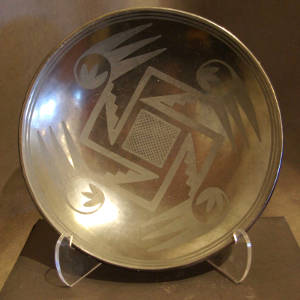
Black-on-black bowl with bird wing and geometric design
Maria Martinez, San Ildefonso
2.5 in H by 12.75 in Dia
Signed: Marie

Black-on-black plate with a ring of feathers design
Maria Martinez & Popovi Da
San Ildefonso
0.75 in H by 6.25 in Dia
Signed: Maria / Popovi
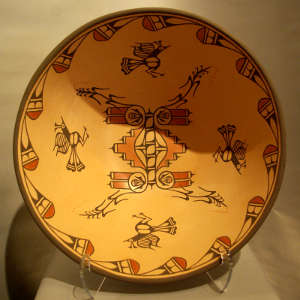
Large polychrome bowl decorated inside with a Zia bird and geometric design, by Ruby Panana, Zia
7.5 in H by 17.25 in Dia
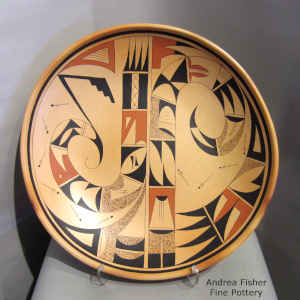
Polychrome platter with bird element, geometric design and fire clouds, by Debbie Clashin, Hopi
2.5 in H by 16.5 in Dia



